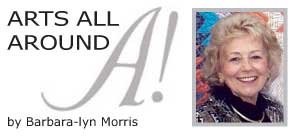

NEW YORK CITY, N.Y. -- Shortly after losing her job at the Whitney Museum in 1977, curator Marcia Tucker founded the New Museum of Contemporary Art. dedicated to "new artists and new ideas." For 22 years, Tucker led the museum's groundbreaking efforts to showcase contemporary artists.
Tucker is acknowledged for leading the earliest museum efforts in the country to engage at-risk secondary school students in art relevant to their lives. She is acclaimed for her scholarly work, especially for a series of art anthologies of criticism entitled Documentary Sources in Contemporary Art. All the while, she managed the New Museum as it operated out of temporary quarters and moved about Manhattan in search of bigger and better exhibition space.
Sadly, Tucker (1940-2006) did not live to witness the opening of a permanent home for the New Museum. Coinciding with the thirtieth anniversary of her bold founding, the shimmering avant garde design of Japanese architects opened to the public on December 1, 2007. It is now THE New York destination for contemporary art lovers and curiosity seekers.
Located in the heart of Manhattan's commercial building supply district, the building both overshadows all that around it and echoes the industrial nature of the neighborhood. Imagine a tall pile of six rectilinear boxes of varying sizes stacked unevenly on top of a glass box; all except the bottom one is covered in the same perforated aluminum-like wrap with some random rectilinear holes. The sidewalks leading to the stack of boxes are lined with building supplies, such as stainless steel sinks and counters as well as myriad plumbing materials, which might have been unpacked from the boxes.
While the exterior generates an initial "wow" response, the interior invites a leisurely paced exploration of the open, friendly and naturally-lit spaces. The ground floor, the Marcia Tucker Hall, is an open, free-of-admission space that includes a caf?, museum store, and glass-walled lobby gallery. The entry-fee upper levels offer three expansive column-free exhibition spaces with daylight provided by the windows in the setbacks created by the uneven stacking of the floors.
The fifth floor education center presents "Museum as Hub," an international collaboration among institutional partners from Egypt, Korea, Mexico and The Netherlands. This floor requires an investment of time and curiosity to appreciating the potential of its interactive workstation. The top floor, open only for special events and on weekends, offers unique panorama views of the city.
The inaugural exhibition year at the New Museum has provided the predictable and the surprising. Predictable is the monumental, leading-edge use of technology to create provocative digital projection art, such as the work of Paul Chan (b.1973).
Chan creates large-scale video projections on floor, ceiling, and walls that run from a half-day to an hour and a half and at the norm of 14 minutes. All in all, it would take more than fifteen hours to view the entire video oeuvre and more for the prints and drawings.
The six Chan video projections relate to the six days of creation while an installation of illustrated sheet music connects with the seventh day of rest. Some projections create a mystical dream-like quality, and others are nothing short of a nightmare. Some seem to be the work one hallucinating; others the composition of genius.
Surprising, to me at least, is the exhibit of fifteen small-scale (187/8 x 15 inches) paintings by Tomma Abts (b1967). A native of Germany, Abts resides in London and was the 2006 recipient of the prestigious British Turner Prize. Her work is exhibited in a cavernous white room with soaring ceiling and several skylights, I thought, "What's new about these small hard-edge abstract paintings? I've seen this pop art for decades."
However, before long I realized those small canvases were unlike any paintings I had ever seen, but I couldn't say why. I just knew I didn't want to leave the room. I yearned to own one so I could really study its mystery. I moved back and forth imagining which one I would choose. I couldn't decide.
The day after visiting the exhibit, I read a review by Ken Johnson (New York Times, April 11, 2008). He wrote about Abts: "...her pictures exert a gravitational force that draws you in and makes you momentarily forget the big empty room. Each seems a little world unto itself....exhilarating."
The Chan and Abts exhibits close at the end of this month. The Abts exhibit travels to the Hammer Museum in Los Angeles, July 27-November 2, 2008. Whatever is showing at the New Museum will be intriguing; the challenge is to be as creative as the structure itself.
IF YOU GO...
I recommend an ABC attitude:
Approach the New Museum on foot for at least a block or two. The contrast to the buildings on either side and the reflection of the commercial nature of the neighborhood can best be appreciated this way.
Be open to the NEW, which may be provocative and most certainly surprising. Use the free Audio Tour or docent-led daily tours at 2 and 4 and Friday at 7pm.
Check ahead for the schedule of public programming possibilities, such as film screenings and presentations by artists, scholars, and critics. Visit newmuseum.org/events or call 212-219-1222.
LOCATION: 235 Bowery, between Stanton and Rivington Streets at the beginning of Prince Street and one and half blocks south of Houston.
HOURS: Wednesday through Sunday, noon to six, extended to 10pm Thursday and Friday.
ADMISSION: Between $6 and $12 with Free Thursday evenings.